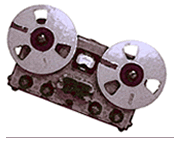


|
Stockhausen's compositions typically proceed from a single governing idea. Here, the idea was to seamlessly fuse the sound of the human voice with electronically generated sounds. At West German Radio's Studio for Electronic Music, Stockhausen analyzed sung verses into their elementary phonetic components, then incorporated these sounds into a timbre continuum that ranged from pure tones (electronically generated sine waves) to white noise (electronically generated aperiodic sound.) To aid in constructing this continuum, the composer transposed, combined, and otherwise altered multiple recordings of the boy's singing. Stockhausen also generated sine wave complexes to create vowel-like sounds and filtered electronically generated noise to arrive at consonant-like sounds. Once the continuum had been constructed, the composer extracted from it the basic elements and groups of elements he would use in composing. The youths referred to in Gesang der Jünglinge's title are the youths in the Bible's Book of Daniel, whom King Nebuchadnezzar threw into a fiery furnace for refusing to worship a golden idol. With amazement, the king then beheld the youths unscathed, singing praises to their God from the heart of the inferno. In Gesang, Stockhausen has used eleven of the verses sung by the youths, presented in a far from straightforward setting. Much is swallowed up in the roar of Stockhausen's electronic fire, but the opening words of each verse, "Preiset den Herrn" ("Praise ye the Lord"), can be heard recurring throughout the composition as a kind of refrain and, on a less audible level, as an element that unifies sections. Gesang is an explicitly religious work, and the words "Preiset den Herrn" are crucial to its meaning. |
The composer subjects material drawn from the verses to numerous permutations which take place on several levels: word, syllable, and phoneme. Thus, if our original sequence is "preiset den Herrn," a different word sequence might yield "den Herrn preiset," a different syllable sequence "prei- Herrn set den," and a different phoneme sequence "eiprs et den nHerr." Besides being varied sequentially, the words are often combined so as to sound simultaneously. As a result of such simple procedures, words flicker in and out of existence. Sometimes a word's meaning is dissolved; at other times, unexpected combinations cause new words to spring into being. Some permutations obviously alter the comprehensibility of the text more drastically than others. This means that in addition to the tone-noise continuum, a second continuum of sense-nonsense is at work. Adding to the piece's complexity is the fact that the sung sounds, like the electronic sounds and "mixed-type" sounds, are varied serially with respect to pitch, volume, and duration. Gesang is, in fact, an impressive example of "total serialism," a method of composing which Stockhausen helped pioneer. One of Gesang's most astonishing and innovative aspects is its spatialization. During the performance, the listener will perceive its sounds moving clockwise and counterclockwise around her. Sounds approach and recede, stand still or zoom away. The spatial dimension of Gesang articulates its form, but more importantly, adds dynamism and drama to this enigmatic piece. Guided by intuition and an unerring sense of drama, Stockhausen has used serial techniques and spatialization in the same way that Bach, centuries earlier, had used counterpoint: as a means to profound expressive and spiritual ends. |